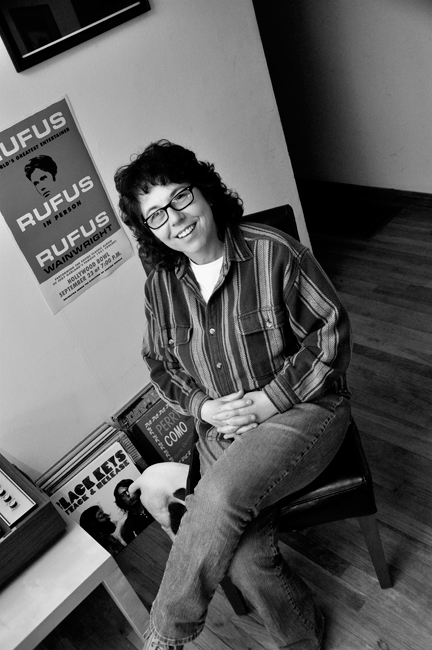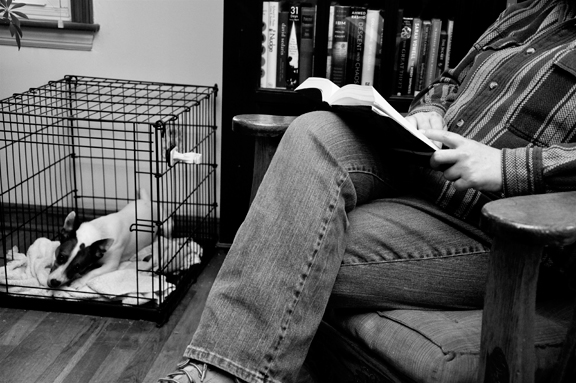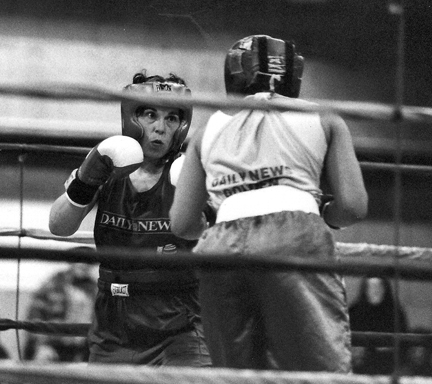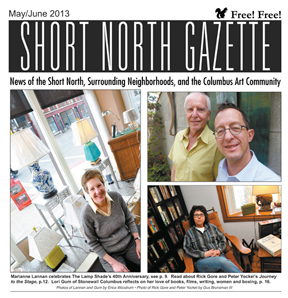
Columbus, Ohio USA
Return to Homepage www.shortnorth.com
Lori Gum
From Boxing to Jewish Mysticism
By Jory Farr
May/June 2013 Issue
Return to Homepage
Return to Features Index
Lori Gum. Photo © Erica Woodrum When she was just 14, Lori Gum went to see a movie that indelibly marked her life. It was a film about a loner, maybe the ultimate loner. “When I saw Taxi Driver, I was a young lesbian who had grown up in Ohio. And suddenly I saw myself represented on screen. It was the first time I witnessed someone so alienated from their surroundings. Travis Bickle was the first character that made me think, ‘That’s how I feel.’”
Gum, who is 50, gets up momentarily from a desk in the board room at Stonewall Columbus headquarters, the gay rights non-profit group where she is the program coordinator, and quickly paces, energized by the memory of that chance encounter long ago.
“I wasn’t a film student then. I didn’t know anything about Robert De Niro or (screenwriter) Paul Schrader or (director) Martin Scorcese. I just knew the date
between Travis Bickle and Cybil Shepherd was exactly a date with me going out with a straight girl I didn’t know. I walked out of that film with my DNA changed. It empowered me. Not through violence. It empowered me that somebody knew what that feeling was like to be gay in the 1970s.
Because there was no Martina, no Ellen, there was no anybody. The only lesbians I knew were in high school ahead of me and they got shut up in a locker and spit on.”
Gum was lucky. When she came out to her parents four years later they were initially shocked and had her see a psychologist. But they were soon completely accepting.
“If I can attribute my success to anyone it’s my parents,” says Gum. “They gave me unconditional love.”
Seen from the angle of fate, Gum’s encounter with Travis Bickle was the right movie to come upon at the right time. It both validated her sense of feeling like an outsider as a gay girl and fired her imagination to be an artist.
Gum says she was aware of wanting to be a writer for as long as she can remember, but certainly by the time she was nine, when her grandparents gave her a gift of Carl Sandburg’s epic biography, Abraham Lincoln: The Prairie Years and the War Years.
“I devoured that book and from that came my obsession with wanting to write. I saw writing from then on in a historical context. Sandburg’s biography was the story of Lincoln – not just the historical figure with facts – but all of the intricacies and details of a life. Sandburg has grown out of fashion now. But the book was compelling. It was the first time I embraced non-fiction, which to this day is what I mostly read.”
Gum, who has frizzy brown hair that falls in ringlets (“She’s a geeky little dyke with a Jew fro,” observed a tweeting stranger on her Facebook About page) and brown eyes. She speaks in a commanding voice. Her words tend to pour out in a torrent and reference everything from obscure foreign films and mystical Judaism to Civil War history and boxing. But she holds a special place for movies.
“Film was my passion from the age of nine onwards. And the ‘70s were a great decade for film.”
She ticks off the pantheon of classics, everything from One Flew Over the Cuckoo’s Nest and Alice Doesn’t Live Here Anymore to Chinatown and Dog Day Afternoon. But then, to tap her deep roots, she goes back further, to Charlie Chaplin’s Modern Times, which she saw at age 12, and cites as a seminal influence.
“I was mesmerized by the way Chaplin used humor and irony to bring light to a serious subject. It was the first time that I thought of a movie as a “film.” That there was another purpose to making movies than just to entertain an audience. I became aware for the first time, upon viewing it, that film was the most powerful medium there was to say something important that you wanted to say. I had never realized that before. Sounds obvious. But it wasn’t to a 12-year-old. And there was something so magical about the way Chaplin used his directing talents and physical gifts to charm an audience into understanding and awareness. All without sound.”
Teeming with influences, Gum landed at Ft. Hayes Arts and Academic High School, known for its innovative arts program and population of creative misfits. There, she spent her junior and senior years among other artists.
“There was no film program,” she says. “But I was involved in the theater department and Ft. Hayes saved me. The school saved me because I was suddenly around kids who were interested in the same things I was. I made life-long friends there.”
Choosing to be a filmmaker – at 13 she had made a stop-action movie that starred a cast of dead ants in a re-creation of the Battle of Gettysburg – Gum went to New York University in the early ‘80s when the university was a mecca for budding auteurs. There, over six years, she made dozens of films – about everything from fairies in the subways to women who worked in a mannequin factory. After NYU, to support herself, she took a job as a spec screenwriter based in New York City. Alas, the ‘70s ethos of indie filmmaking was over, largely replaced by a consumerist, disposable notion of movies.
“I lived on options,” Gum says, smiling ever so ironically. “Nothing was ever produced.”
For a time, from 1986 to 1987, she worked on “Tales From the Darkside,” the popular horror TV show. She was an assistant to the editor, doing the grunt work.
“I quickly learned what worked storywise and dramatically,” Gum says. “Even if it was a ridiculous plot, there still was an arc to the story.”
Gum got to meet a lot of soon-to-be-famous people, such as Jodie Foster. And she says it was a good training for how to put together a show quickly. But she instinctively refused to move to Hollywood to find other opportunities. Ultimately, she found the movie industry sleazy and abandoned it.
“I gave it up because ‘Hollywood’ was a cesspool. Everyone I met was shallow, dishonest and cocaine-addicted. And writing films, or more importantly, trying to sell them, was the most demoralizing experience of my life. At that time, it was very difficult to sell a story with marginalized characters such as black, poor, gay or Asian or even women. I wrote stories and characters that may have had a chance in the ‘70s, but not in the ‘80s and ‘90s.”
Gum lived for four years in Orange County, involved in a relationship. The time in the Golden State only confirmed her loathing of California. When she did return to Ohio it wasn’t to be an activist. She came to work for her parent’s glass company in 2007 as an engineering manager and never suspected Stonewall Columbus would offer her a job three years later. Yet she’d been involved with activism before, in New York in the mid- and late-80s.
“That was when I turned around and everyone I knew was dead or dying. This was in the shank of the AIDS epidemic. All I could think of was to join Act Up. Something had to be done.”
Act Up was committed to direct action to end the AIDS crisis. The group demonstrated at Wall Street and demanded greater access to drugs to treat the pandemic. But though Gum was an ardent supporter, she was wary of the shrill politics and infighting of much activism. At Stonewall, political discussions, says Gum, are not part of the discourse “because we want to be the community center for everyone.”* * *
© Erica Woodrum Gum grew up in Westerville, the oldest of two children. Her father started and owned his own glass and glazing business, Thomas Glass Company. Her mother was a housewife. Gum says she had a happy childhood. She excelled in sports, read voraciously and lived in a safe, supportive environment. Her parents always stressed honesty and kindness and the house was often deeply quiet, everyone immersed in reading.
“My parents were voracious readers and the house was filled with books. My father was a huge history buff and it rubbed off. We would spend our summers visiting Civil War battlefields. I loved it.”
Gums says her parents always told her she could do anything she put her mind to.
“I ended up believing it, too. I think that is the best gift that a parent can give to a child. That belief in their own capabilities. They told me I could do anything, so I went out and tried to do everything. Therefore, I may have misconstrued their original sentiments a bit.”
By temperament, Gum knew she was different. For one thing, she was entirely comfortable with long stretches of solitude, not needful of companionship. For another, she was a fervent bibliophile.
“I was always quite a loner from a very young age and had very very few close friends,” Gum says. “I just didn’t want them. I have always enjoyed being alone and for as long as I can remember I have always felt different. And I don’t mean just because I am a lesbian. I just always seemed interested in things other people weren’t interested in and wanted to go places that no one else wanted to go. And that was okay. It still is. I often prefer it. As a general rule, books have always been my best friends and my greatest and truest companions.”
The knowledge of her own sexuality came to her at age nine and, she says, never bothered her. Rather, she immediately accepted it.
“I was never scared or worried about it.
I was kind of excited,” says Gum. “But I damn sure knew that I didn’t dare tell anyone about it. I knew society would view it as wrong. I just knew I had to keep it a secret and still try to let girls know I was interested. And that was a tough task for a 12- or 13-year-old. It worked though. I had my first girlfriend at age 13. I became an avid observer of human nature by that time. That may have had a lot to do with why I became a writer. I was always trying to figure out what other people were thinking.”Being different also meant that Gum stood apart and was something of an outsider as a youth.
“I never went to other kids’ birthday parties or anything like that,” says Gum. “My mom wanted me to, but I wouldn’t. I never really understood why people thought parties were fun. I still don’t get why people think parties are fun. Then, of course, I started to feel even more different when I realized I was attracted to girls. But I already felt so different that it really didn’t bother me that I was even more different. I cannot remember once in my life caring what anyone else thought of me in regard to my being different or not going with the crowd. I of course want people to respect me, but I don’t care if they approve of me.”
“As far back as I can remember, 40 years ago, Lori knew her path in life,” says Terri Jones, a friend who has know Gum since third grade.
“Nothing intimidated her from following her dream of attending NYU and nothing excited her more than being in the thick of New York City. Lori loved the arts and its eclectic lifestyle and that passion continues today. When we were in high school, I especially remember being amazed by her vision after attending some of her play productions at Ft. Hayes. What is entertaining to me is that when we get together, I have to mentally rehearse the weighty words that she uses in conversation, so I can go home and look up the definitions.”Karla Rothan, the executive director of Stonewall Columbus who hired Gum, calls Gum “one of a kind.”
“I met Lori when she worked for her dad’s business, Thomas Glass, and she was the engineer on the project. From day one, I could tell that she was a professional with a keen sense and an outstanding attention for detail. We became friends and Lori volunteered to help me with the Pride celebration as the vendor liaison. I knew she would be perfect because she could handle high stress situations with patience and humor. She was also great with customers providing the best and most complete service to our vendors than had ever been delivered before that year. “She is one of the most intelligent people that I have ever met. But she uses that intelligence wisely, never making anyone feel uncomfortable and always making them feel included in the conversation.”
Nine months before she took the job at Stonewall, Gum took a chunk of her savings and put it into Periodisa Publishing, a venture she formed to present local journalists, artists, poets and authors. It was something she’d been meaning to do, and the result was the bimonthly arts journal “Filigree.” Periodisa has also published a novel Jackson Falls, by Terry Bowman, and a book called Hot 17, Vol. 2, about local bands. “Filigree,” whose purpose was to encourage reading and writing, has broken even. But Hot 17 lost all of Gum’s investment.
“I sunk a lot into that. I discovered that people in Columbus will spend money on a book about food but not on music. And we had everything: the writers, the bands, the photographs. It just didn’t sell.”
Besides her gigs at Stonewall and Periodisa, Gum writes for 614 Magazine. And she has other big projects going. Currently, she’s in the midst of writing a musical called a “Thinly Veiled Threat,” about an AWOL American Special Forces Officer who tries to save a 12-year-old female suicide bomber from the clutches of evil.
“It’s got minor-keyed-cabaret-style ballads, WPA-style work songs, high-drama, savage political commentary and ironic hilarity,” says Gum, who admits to possibly needing help with the musical’s lyrics.
Gum has also begun research on a book about Ohio’s historical place in presidential elections, in which she’s tracing every election, beginning in 1804. She expects the book to take five years to complete.
“For writing, the genesis has to have come organically. I write in my mind first and then it’s on the paper. My thoughts are bigger than the paper will hold,” she says.
All told, she thinks the best thing she’s written is “Glad Tomorrows,” a screenplay about a black family raising a white child in the ‘40s in Mississippi that she spent about five years on.
“I learned the language of the area by spending a summer in 1985 in Yazoo City, where the story is set. Later I had a staged reading. We had some interest in Hollywood, but it never sold. But it’s still the bar for me.”
These days, Gum says she has achieved a balance between activism – although she hesitates to call herself an activist inasmuch as she’s not putting her life on the line – and writing. As the program coordinator for Stonewall Columbus, she manages and writes grants, administers the Trailblazer Program for members over 50, puts on film presentations, anti-bullying initiatives, holds a grief support group and helps oversee the Pride Festival, a two-day celebration in June that drew more than 250,000 people last year.
“Stonewall is the place where I can put together all my talents,” Gum says. “But I still haven’t found my purpose in life. I just always go through an open door.”
One could say she’s found many purposes, one of which includes converting to Judaism in 1998. But even here she was a non-conformist.
“I was not raised in a church-going family and since my teens had a problem with Jesus Christ. I didn’t believe he was the son of God,” Gum says. “Well, in my early twenties I read the Torah, the Zohar and the Kabbalah and I taught myself Hebrew.”
Gum says she was attracted to Judaism’s strong literary tradition and the rigors of its self-questioning style.
“I love the depth of the intellectual investigation into something that is essentially unknowable. The scholars and rabbis basically say this all may be unknowable, but that is not going to stop us from trying to understand it anyway. It’s a complete contradiction that is embraced with undying dedication and commitment. Which brings me to a favorite rabbinical saying: ‘Truth can only be found at the heart of a paradox.’ I believe that whole-heartedly and that to me is the entire history and mystery of Judaism: That spiritual demand to relentlessly think about our illogical and contradictory human existence in the cosmos.”
From 1994 to 2001, Lori Gum was a serious amateur boxer in New York City. This is the 2001 Golden Gloves Women's Welterweight Semi-final: Lori vs. Micki Pryor. © Photo courtesy of Lori Gum It’s hard to believe that Gum, rebel lesbian, filmmaker, screen writer and LGBT activist is familiar with secret Kabbalists, Hasidic scholars, Hannah Arendt, Jewish mystics, half-mad rabbis, the Baal-Shem-Tov and the arcane complexities of Hebrew law. But then she is full of surprises. As the sky darkens on this early March day, Gum talks freely about another passion – boxing. From1994 to 2001, she was a serious amateur boxer in New York City, spending four hours in the gym every day for six days a week “Boxing is a consummate physical and spiritual challenge,” she says. “That is what I found most attractive about the sport. You are facing yourself in that ring much more so than you are facing an opponent. And you are doing it completely alone. Simply put, it takes real courage to enter a ring with someone whose mission is to hit you, hurt you, knock you down. And that experience of finding that courage – or not – puts you in a very unique place to understand yourself and others. Boxing is somewhat of an exercise in paradox. You are attacking another and defending yourself simultaneously, often in the same movement and moment.”
In boxing, Gum found an exercise in discipline and an outlet for physical prowess.
“It is not about destructive violence.
Violence is chaotic and anarchic. Boxing is about controlling the impulses and instincts that create destructive violence and corralling your body to serve your mind and your intellect.”
Because she was already too old for USA Boxing sanctioned bouts (33 was their maximum then), most of her fights were within the same gym and in bouts with fighters from other gyms – very serious business in Manhattan and Brooklyn.
“Back in those days there were no women to fight, so I sparred and fought mostly against men,” says Gum, “of which there is no official record. As women began to become more prevalent in the sport, in 2001, when I was 39, I finally forged my birth certificate and fought in the 2001 New York City Golden Gloves in the women’s welterweight division. I made it all the way to the semi-finals, when I then drew the 25-year-old then-current world champion, Mickey Pryor, who proceeded to dominate me entirely and defeat me with several knockdowns. But I finished the fight standing up.
“I ended up with a Bronze medal in the division. It was the first time, in six years, that I had actually been really hurt. It took me two months to recover. I was just too old. If professional boxing had been available to women when I was young, I have no doubt that I would have chosen that as my profession. Some of my very favorite moments of my life were in a boxing ring. And some of the most fascinating people I have ever met were boxers. Some of the smartest too.”
Though she lived in New York for 20 years, she is happy to be back in the Midwest. New York has its great writers and fevered egos. It has real bagels and Greenwich Village and the Hayden Planetarium. But the Midwest has something else.
“There is an inherent optimism in Midwestern writers,” Gum says. “There’s a willingness to embrace strangers. There is a spiritual resilience to Midwestern writing. And I want to investigate that more.”Jory Farr, the author of Rites of Rhythm: The Music of Cuba (ReganBooks/HarperCollins), last wrote on the artist Charles Wince.
© 2013 Short North Gazette, Columbus, Ohio. All rights reserved.
Return to Homepage www.shortnorth.com



